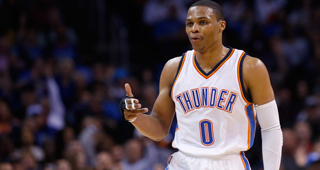Russell Westbrook is either the pinnacle of human athletic greatness or an alien. To analyze Westbrook is to not get Westbrook; he’s best understood by observing him as you would a human installation piece at MoMA.
Westbrook belongs to the cadre of lead guard superstars that play the game under the ethos of “live fast, die young and have a good-looking corpse.” Their runs are short-lived and they aren’t judged in rings as much as how they play as an artifact of the zeitgeist.
We have spent hours watching Westbrook highlights in six-second Vine highlights. Dominique Wilkins was "The Human Highlight Film" and Westbrook is "The Human Vine Loop."
During the three-point era, there have been 18 different point guards to have two or more seasons in which they average 20 or more points with an eFG% above .450 and six or more assists per game.
Westbrook, Stephen Curry, Tony Parker, Chris Paul, Derrick Rose and Deron Williams are active players on this list. Kyrie Irving and Isaiah Thomas each did it last season, but not so far in 14-15 for either player. Damian Lillard could join the club as a first-timer this season.
The retired legends of this type of production are Gary Payton (7), Stephon Marbury (7), Allen Iverson (6), Tim Hardaway (5), Kevin Johnson (5), Isiah Thomas (5), Magic Johnson (4), Baron Davis (3), Gilbert Arenas (2), Steve Francis (2) and Penny Hardaway (2). Payton had the best longevity sustaining this level of play, still doing it at 33 and 34.
Jason Kidd, Steve Nash and John Stockton all played through the age of 40, but their games were never predicated on being scorers and their effectiveness remained after whatever athleticism they once had faded.
Westbrook is the logical progression of the uber athletic scoring point guard of the late nineties and early aughts of Marbury, Francis, Davis and Arenas. His peak has been better than any of theirs, but the critical question will be how much longer will it last?
Francis was barely that player for long and stopped being such at 25.
Arenas was a Hibachi blip that couldn’t stay healthy and his 60-point outburst has faded into a footnote.
Davis became next level great at 27 in 2007 and you can debate if it was Donald Sterling, Elton Brand doing a bait and switch, or his off-court priorities that ended his dominance at 29, or if it was just that time regardless.
Marbury had his last of those seasons at the age of 27 with the New York Knicks before a number of factors quickly brought along his end.
The Thunder nearly drafted Brook Lopez over Westbrook and I was unfortunately on record of believing Jerryd Bayless was the better point guard fit of that draft since he could play off the ball with Kevin Durant. Sam Presti was gambling on Westbrook becoming more than a scoring 6th man and defensive menace.
The Thunder had an incubation period to offer Westbrook, which let him channel the chip he plays with, along with his length and alien athleticism into becoming something approaching a real point guard on top of that.
Westbrook never even becomes WESTBROOK in so many other situations. Westbrook went to a patient franchise not needing/not caring/not wanting to win immediately in his rookie season with their sights on drafting James Harden in 2009. Westbrook was allowed to play with his reality distortion field.
The first taste of the playoffs came quickly in his second season and they took the eventual champion Lakers to six. Most importantly, Westbrook was able to grow into his game against defenses preparing for him being the second option on a team with one of the ten best offensive forces to ever play.
In 2012, Presti effectively chose Westbrook over Harden and part of that calculus had to involve projecting how long their respective peaks would last. Harden is a year younger than Westbrook and The Beard’s old man game of drawing fouls, creating assists and shooting three-pointers will be in many meaningful ways nearly as good at 35 as it is now at 25. Manu Ginobili still has 20+ effective minutes per night in his mid to late-30s.
Westbrook will probably be all-in on fashion by the time he’s 35, but who knows with him. Westbrook attacks the paint and the basket as a force of nature with every takeoff possibly being his last and having no fear of that reality.
The window may be shorter with Westbrook, but it also burns brighter.
On an athletic level, Westbrook is a combination of violence and being Russell Westbrook. Westbrook plays with the type of energy as though he’s on bulletproof coffee. The Thunder can build their late game offense through the Westbrook pick-and-roll with Durant spotting up or more dangerously as the screener. Westbrook has improved so dramatically as a passer in those sets and there’s really nothing a defense can do except pack the paint to take away his air space and pray those perimeter looks result in more misses than makes.
Running the offense through Durant is of course an exceptional option, but it also has fewer variables for the defense to deal with. Durant is a far better passer from a stationary position than he is off the dribble and he of course doesn’t get to the basket as quickly as Westbrook, both of which gives the defense an edge on rotations.
Westbrook is making a concerted effort to eliminate long two-point attempts and he’s also working on reducing low quality three-point attempts. A Westbrook with improved shot selection that remains calm and without panic in the fourth quarter of important games is the most dangerous weapon in basketball.
Durant’s free agency decision comes in 2016, one year ahead of the Westbrook and Ibaka free agencies, as well as one year ahead of Westbrook at the hazardous age of 29. That’s still two postseasons away and they’re the prohibitive favorite in both assuming full health.
Westbrook doesn’t know what memes are, but that image of him eyeing Durant’s MVP trophy is real, both in desire and possibility.



